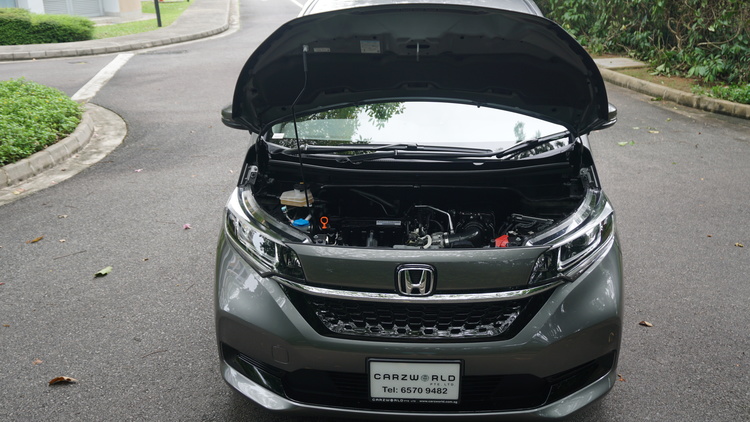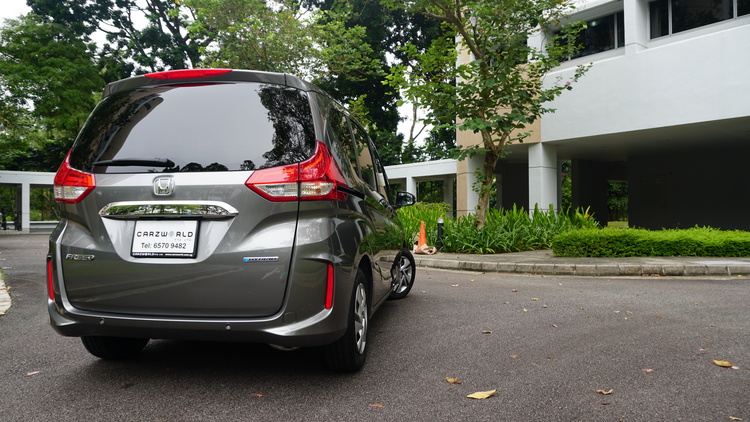mReview: 2020 Honda Freed Hybrid - Better than the Sienta?

The Honda Freed Hybrid may not be as smartly-packaged on the inside compared to its chief rival, the Toyota Sienta, but it has a less embarrassing design, and promises a far more inspiring driving experience!
"Freed Hybrid or Sienta Hybrid?" That may be the question that's on your mind if you're someone looking to buy a practical, fuel-efficient ride that's safe and sensible for your family. In this review, we'll be taking a look at the refreshed 2020 Honda Freed Hybrid.
At first glance, the Honda Freed Hybrid seems like yet another boring, uninspiring, bread van of a seven-seater MPV, much like its chief rival, the Toyota Sienta Hybrid. On the contrary, the Freed Hybrid is actually far more car-like and sportier to drive than the Toyota. More on that later. First, let's look at the design of this MPV.

You may scoff: "What's there to look at? Isn't this just a boxy MPV?" Yes, but this is the facelift 2020 Honda Freed Hybrid, which sports a different grille. For some contrast, this is how it looks like beside the pre-facelift model:

More importantly, the Freed Hybrid looks just like an ordinary compact minivan. That might be boring in its own right, but it appears to be handsome when compared to Sienta Hybrid, whose exterior is an over-designed mix of bulbous curves. You get a mix of curves and lines coupled with stark orange trim and quilted-effect stitching in the Sienta Hybrid, while the Freed Hybrid comes with a neater interior that has cleaner lines and nice wood-effect trim. The Freed Hybrid's interior also makes you feel like you're in a nice Japanese zen lounge, while the Sienta Hybrid's interior gives you the impression that the driver - likely a family man/woman - is trying too hard to pretend to still be part of a "voice of da yoof".
Let's not pretend. Both cars are family MPVs, so let's look at the features and amenities of the Freed Hybrid, and contrast them against those on the Sienta Hybrid.
Features and Amenities
- Keyless Entry
Much like the Sienta Hybrid, the Freed Hybrid comes with keyless entry, and it doesn't use the more cost-effective system that requires you to press a button on the door handle to lock or unlock the car. Instead, all you need to do is place your hand in the door handle and pull to unlock the car. Surprisingly, the Sienta Hybrid also boasts this feature as well. Not bad for cars that are affordable for the average Singaporean.
- Powered Doors

In this area, both the Freed Hybrid and Sienta Hybrid are equally matched. Both cars have dual electric sliding doors that can be controlled through the car's remote, the control panel in the driver's area, and through the rear door handles.
- Cabin Space

The sliding doors of the Freed Hybrid opens up a spacious second row; however, it does feel like there is less rear passenger space as compared to the Sienta Hybrid, although we don't have exact figures to compare against. This problem is further exacerbated by a low seating position that provides insufficient thigh support.

The Freed Hybrid does redeem itself with its 60:40 split folding second-row seats, which also comes with a centre armrest. Compared to the Sienta Hybrid, which has a 50:50 split folding configuration and no armrest, the Freed's second row seating arrangement is far more comfortable. When carrying two passengers, the centre armrest can be folded down, and this is a good feature to have, considering that the design of the sliding doors means that there aren't any side armrests. When carrying three passengers abreast, the 60:40 split folding seating design also means that the centre passenger isn't sitting on a valley that splits themselves through the middle, as in the case of the Sienta Hybrid, with its 50:50 seating configuration.
On this front, the Honda scores some points against the Toyota, although it is regrettable that the seats are too low to provide good under-thigh support.
- Versatility
In our review of the Toyota Sienta Hybrid, we gushed about the ingenious design for the third-row seats. When not in use, they fold neatly underneath the second-row seats, and simply spring up and lock into place when you need them with just the pull of a tab.
With Honda being well-known for its good interior packaging to magically make their cars bigger on the inside than on the outside, we were expecting something similar to what the Toyota offered. Instead, we were disappointed to find that Honda simply tacked the third-row seats onto the sides of the cabin, and that the seats stow away by being folded up, thus blocking the glass and affecting driver visibility.

To put down the seats, one has to unhook the seats from their mounting points, and then fold out the stands underneath the seats before locking them down in place. Some lifting is actually required in the Freed Hybrid, unlike in the Sienta Hybrid where everything just springs into place.
Granted, this is a far less elegant design solution than that of the Sienta Hybrid's, but one major advantage of the Honda Freed Hybrid's third-row seat design is that one can put down and stow away the seats from the rear, whereas the Sienta Hybrid requires you to walk over to the second row to tumble the seats down, and back to the rear to fold the seats into the second row, and then reach back to the second row to put the second-row seats up.
Furthermore, although the seats do block the rear visibility slightly when they are folded up, it isn't too much of an issue since the car's boxy dimensions means that it is easy to see out of any way.

Space in the third row is basically the same as in the Sienta Hybrid. Good for children, and recommended only for adults whom you dislike and want to torture. Third-row passengers do get their own cupholder, though, so it's not all bad.
On the Move
- Power
Unlike the Sienta Hybrid which has a paltry 97hp with a sluggish CVT powertrain, the Honda Freed Hybrid boasts 135hp and a quick-shifting dual clutch transmission. This makes the Freed Hybrid almost like a sports car compared to its rival.
Tap on the accelerator and the car just moves forward, and you'll never feel like the car is lacking in power anywhere, not even on the highway. This is something that just can't be said about the Sienta Hybrid.

Although Honda used a hybrid powertrain in the Freed Hybrid to maximise fuel economy, its pairing to a dual-clutch transmission has made the car's response sharp, and we would unequivocally say that it is far better than the Sienta on this front.
- Refinement
Sound insulation on the Honda Freed Hybrid is good, and it does a good job in suppressing noise, considering that the car's boxy design makes it an echo chamber for noise to bounce off. Wind insulation is generally good, even at highway speeds. However, road noise is present from very low speeds.
- Driving Experience
The Freed Hybrid feels like any other "normal" car to drive, and this is no small compliment considering its tall and boxy dimensions. In the driver's seat, the car seems to wrap around you, and you feel like you can take corners with confidence. The steering is strongly assisted and light, but you're still able to place the car where you want it to go. All these are great driving traits are nowhere to be found in the Sienta Hybrid, which is sluggish to respond to throttle inputs, and bobs around the bends as though one were piloting a ship instead.

In terms of actual manoeuvrability, the Freed Hybrid's turning radius is 5.9m, which is more than that of the Sienta Hybrid's 5.2m. This is a classic case where the statistics don't actually match up with the driving feel, as the Honda feels far more agile and ready to respond to steering inputs.
Much like in the case of the Sienta Hybrid, the Honda Freed's boxy dimensions provides a large greenhouse space, and visibility is not an issue, even with the third-row seats stowed up.
Safety
The Honda Freed Hybrid comes with Honda Sensing, which entails Collision Mitigation Braking System (CMBS), Road Departure Mitigation System (RDM), Adaptive Cruise Control (ACC), Lane Keeping Assist System (LKAS), and preceding vehicle start notification function. Although the Sienta Hybrid comes with Toyota Safety Sense, the Honda Sensing package found in the Freed Hybrid seems more comprehensive and easy to use.

Furthermore, the Freed Hybrid also has traffic sign recognition, which reminds you of the speed limits, and alerts you if you're driving into a one-way street that's marked by a "no entry" sign.
Conclusion

The Honda Freed Hybrid has truly wowed us with the way it drives. Having first tested the Toyota Sienta Hybrid, we were expecting yet another bread van that was sluggish and rolled about like a cruise ship. Instead, what we got was a relatively sharp and responsive car that belied its MPV appearances. If you're looking for a compact family MPV that can still provide you with a car-like feel, the Honda Freed Hybrid is the car for you.
The Sienta Hybrid was designed in a way that shouted that it was unembarrassed about being an van-like MPV, but the Honda Freed seems like a more grown-up package - it is more reserved and confident about its capabilities. Additionally, the Freed Hybrid also feels like a better-built car than the Sienta. The tailgate on the Honda shuts with a more reassuring singular "thud" than on the Toyota's, which feels like you're slamming down the tailgate of a panel van.
The key question is perhaps, considering the Freed Hybrid's less well-designed third-row storage system, and the use of hard plastic trim everywhere in the car, whether the advantages in the car's driving dynamics truly command a roughly S$8,000 - 10,000 premium over a similarly-equipped Toyota Sienta Hybrid (with LED lamps and Toyota Safety Sense). This is a question that only you can decide for yourself.
If you're interested to find out more about the Honda Freed Hybrid, please contact Jezelle at +65 8127 3019.
Schedule a phone call or no-obligation test drive to find out more
Specs
|
Price: |
S$110,988 |
|
Performance: |
Engine: 1496cc Naturally Aspirated Inline 4-Cylinder DOHC i-VTEC, with a 30hp Hybrid Motor Power: 135hp (Combined) Torque: 134nm Fuel Consumption: 25km/l 0-100km/h: Unknown Top Speed: Unknown Drivetrain: 7-Speed DCT/Front-Wheel Drive Brakes: Ventilated Disc (Front), Disc (Rear) |
|
Measurements: |
Wheelbase: 2,750mm Dimensions (LxWxH): 4265mm x 1695mm x 1710mm Weight: 1440kg Fuel Tank Capacity: 36l Boot Capacity: Unknown |
|
Features: |
Honda Sensing Auto Headlights Climate Control Keyless Entry Electrically Retractable Side Mirrors Dual Power Sliding Doors |
*The observant reader may notice that the test car is missing its centre infotainment screen. This will be installed before the car is delivered to owners.
Read More: mReview: Toyota Sienta Hybrid - Unabashedly Family-Friendly
Download the new Motorist App now. Designed by drivers for drivers, this all-in-one app lets you receive the latest traffic updates, gives you access to live traffic cameras, and helps you manage LTA and vehicle matters.
Did you know we have a Motorist Telegram Channel ? Created exclusively for drivers and car owners in Singapore, you can get instant info about our latest promotions, articles, tips & hacks, or simply chat with the Motorist Team and fellow drivers.


